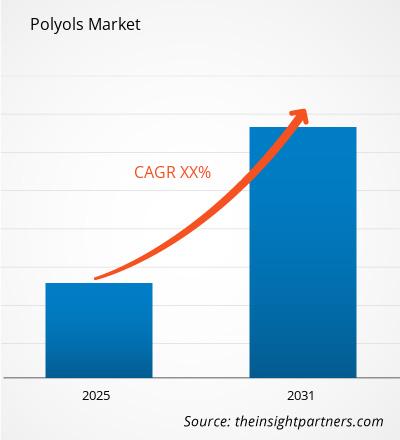Analyst Perspective
The global polyols market is expected to register a CAGR of 6.0%. Polyols play a significant role in manufacturing polyurethane, a material used in various applications, including construction, automotive, furniture, and others. Polyurethane serves as a replacement for traditional materials like wood, rubber, and metal. An increase in demand for different derivatives of polyols, such as flexible polyurethane foams, elastomers, and coatings, mainly drives the polyols market. Expansion in manufacturing, new product launches, and technological advancements are possible growth opportunities. Alternative products and government regulations on reducing reliance on petroleum-based products are significant challenges for the polyols market.
Market Overview
Polyols are found in various applications, including construction, automotive, electronics, and especially in the production of polyurethane. Polyols are primarily used in polyurethane foams for cushioning, such as furniture, bedding, and car seats. Rigid polyurethane foams are used in the construction industry. Rising efforts for energy conservation are driving demand for rigid foams with high insulation properties, particularly in the building and construction industry. There are different types of polyols used for different purposes. Consumer awareness and preference for eco-friendly products impact the polyols market. Increasing consumer awareness about environmentally friendly products has influenced industries to adopt polyols in response to changing preferences. Ongoing research and development in polyol production methods and formulations further contribute to the growth of the polyols market. The construction industries in various economies show growth opportunities for the polyols market.
Market Drivers
- Increasing demand for polyurethane production
Polyols play a vital role in producing polyurethane, a versatile polymer used in the construction, automotive, and furniture industries. The growth of these end-user industries directly impacts the demand for polyols. The ability to tailor polyurethane formulations to meet specific requirements of industries looking for customized solutions contributing to increased demand.
- Growth in construction and infrastructure sector
The construction sector extensively uses polyurethane foams and insulation materials, a significant driver for the polyols market. Urbanization and infrastructure development contribute to the demand for polyols-based products. In addition, emerging economies, technological advancement versatile applications are also significant factors driving the polyols market
Market Segmentation
The global polyols market is segmented based on type, application, and end-use. The global polyols market is segmented based on type: polyether, polyester, and others. The polyols market is segmented based on applying flexible polyurethane foams, rigid polyurethane foams, adhesives & sealants, and others. The global polyols market is segmented based on end-use into building & construction, automotive, furniture, electronics, and others.
Regional Analysis
The report provides a detailed industry overview, which includes qualitative and quantitative information. It gives information on an overview and forecast of the global polyols market based on several segments. It also provides market size and forecast estimates from 2021 to 2031 concerning five major regions: North America, Asia-Pacific (APAC), Europe, Middle East & Africa (MEA) and South & Central America. The polyols market by region is also sub-segmented by respective countries and segments. The polyols market report covers an analysis and forecast of 18 countries globally and the prevailing trends and opportunities in the region.
The report analyses factors affecting the polyols market from both the demand and supply side. Furthermore, it evaluates market dynamics during the forecast period, i.e., drivers, challenges, opportunities, and future trends. The report also provides an extensive Porter's Five Forces analysis highlighting factors affecting the polyols market in these regions.
Key Players
The reports cover vital organic and inorganic growth strategy developments in the polyols market. Various companies concentrate on organic growth strategies such as product launches, approvals, patents, and others. Inorganic growth strategies activities observed in the market were partnerships & collaborations and acquisitions. These activities have paved the way for the development of the business and customer base of market players. The market players in the polyols market are anticipated to have lucrative growth opportunities with the increasing demand for polyurethane in the global market.
The report includes key companies' profiles, SWOT analysis, and polyols' market strategies. The report also focuses on leading market players with information including company profiles, components, and services offered, financial information for the last three years, and critical development in the past five years.
Below is a list of companies engaged in the polyols market.
- The Dow Chemical Company
- BASF SE
- Covestro AG
- Coim Group
- Mitsui Chemicals
- Expanded polymer systems
- Solvay SA
- Stepan Company
- Vertellus
- Repsol SA
Polyols Report Scope
| Report Attribute | Details |
|---|---|
| Market size in 2024 | US$ XX million |
| Market Size by 2031 | US$ XX Million |
| Global CAGR (2025 - 2031) | XX% |
| Historical Data | 2021-2023 |
| Forecast period | 2025-2031 |
| Segments Covered |
By Type
|
| Regions and Countries Covered | North America
|
| Market leaders and key company profiles |
- Historical Analysis (2 Years), Base Year, Forecast (7 Years) with CAGR
- PEST and SWOT Analysis
- Market Size Value / Volume - Global, Regional, Country
- Industry and Competitive Landscape
- Excel Dataset



Report Coverage
Revenue forecast, Company Analysis, Industry landscape, Growth factors, and Trends

Segment Covered
This text is related
to segments covered.

Regional Scope
North America, Europe, Asia Pacific, Middle East & Africa, South & Central America

Country Scope
This text is related
to country scope.
Trends and growth analysis reports related to Chemicals and Materials : READ MORE..
The List of Companies
- BASF SE
- Coim Group
- Covestro AG
- Expanded Polymer Systems Pvt. Ltd.
- INVISTA (Koch Industries, Inc.)
- Mitsui Chemicals, Inc.
- Polyols & Polymers Pvt.Ltd.
- Royal Dutch Shell plc
- Stepan Company
- Vertellus Holdings LLC

 Get Free Sample For
Get Free Sample For